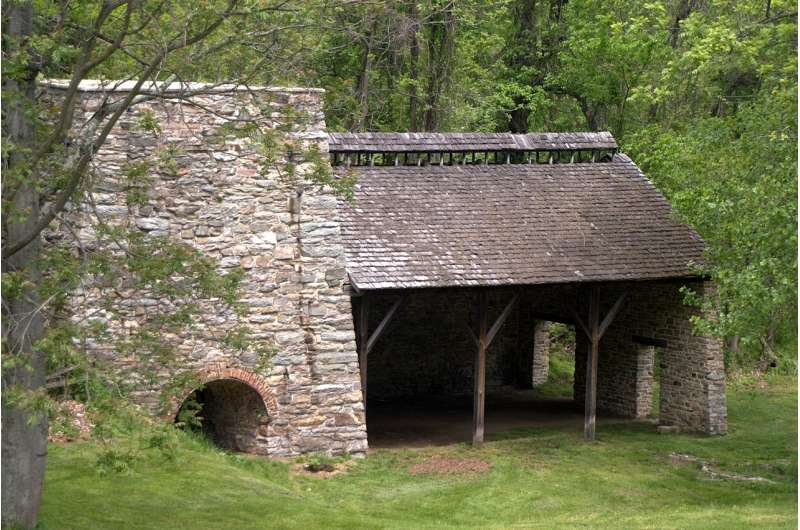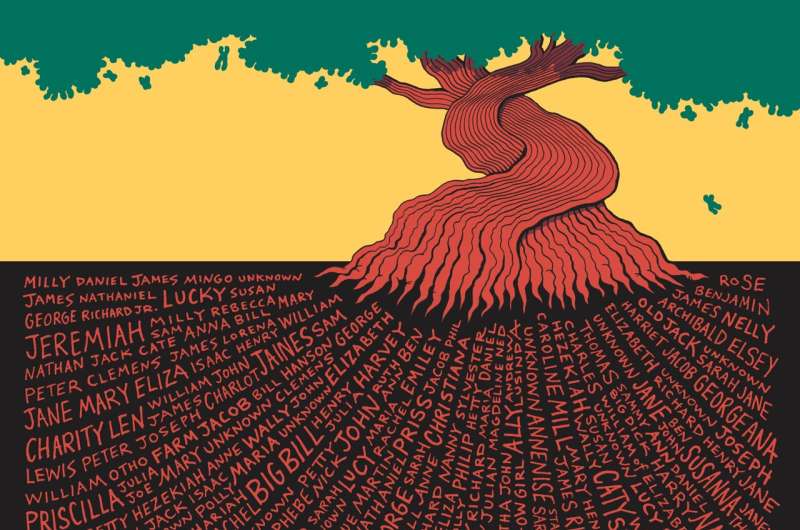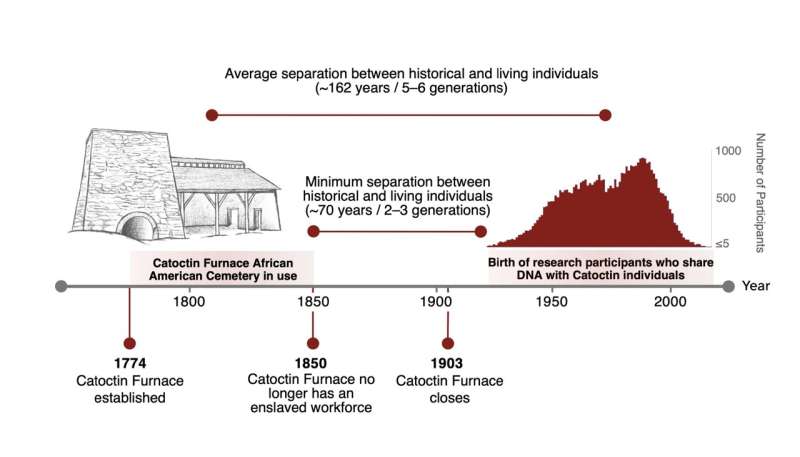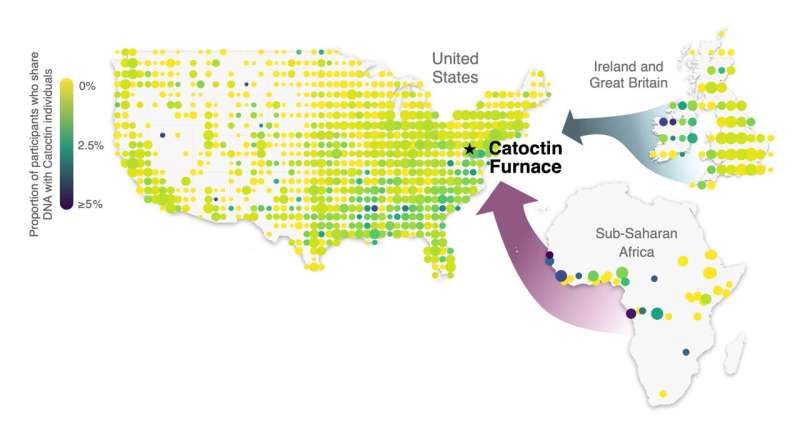This article has been reviewed according to Science X's editorial process and policies. Editors have highlighted the following attributes while ensuring the content's credibility:
fact-checked
peer-reviewed publication
trusted source
proofread
Historical DNA study connects living people to enslaved and free African Americans at early ironworks

A first-of-its-kind analysis of historical DNA ties tens of thousands of living people to enslaved and free African Americans who labored at an iron forge in Maryland known as Catoctin Furnace soon after the founding of the United States.
The study, spurred by groups seeking to restore ancestry knowledge to African American communities, provides a new way to complement genealogical, historical, bioarchaeological, and biochemical efforts to reconstruct the life histories of people omitted from written records and identify their present-day relatives.
The research represents a collaboration among Harvard University, the Smithsonian Institution, the genetic testing company 23andMe, and the Catoctin Furnace Historical Society.
Described Aug. 4 in Science, the work reveals how 27 individuals buried at Catoctin Furnace were related to each other, the genetic conditions they may have had, where in Africa and Europe they or their ancestors likely came from, and where in the U.S. they have descendants and other genetic relatives living today.
"Recovering African American individuals' direct genetic connections to ancestors heretofore buried in the slave past is a giant leap forward both scientifically and genealogically, opening new possibilities for those passionate about the search for their own family roots," said study co-author Henry Louis Gates Jr., the Alphonse Fletcher University Professor and director of the Hutchins Center for African & African American Research in Harvard University's Faculty of Arts and Sciences.
Until now, genetic insights into the identities and ancestries of early African Americans were limited to what could be gleaned from mitochondrial DNA, which is passed down through mothers; from Y-chromosome DNA in males; and from comparisons to DNA sequences in moderately sized public databases that often lack sufficient numbers of Black participants.
The new study makes an advance by sequencing sites from across the historical individuals' entire genomes, comparing the sequences to a database with de-identified DNA information from more than 9 million living people, and using a new method to determine how genetically related people are.
The work is the first to link up ancient DNA technology with a personal ancestry testing database and to use the new algorithm.
"Our study combines for the first time two transformative developments in genomics in the last decade: ancient DNA technology, which makes it possible to efficiently sequence whole-genome data from human remains, and direct-to-consumer genetic databases that contain data from millions of people who have consented to participate in research," said co-senior author David Reich, professor of genetics in the Blavatnik Institute at Harvard Medical School and professor of human evolutionary biology in Harvard's FAS.
"This work demonstrates the power of DNA to provide information about ancestral origins," he added.
The authors have made the Catoctin Furnace data publicly available for other researchers and amateur geneticists. However, they caution that establishing genetic relationships between living people and those from Catoctin should be handled with the utmost sensitivity, as outlined in a companion paper published in the American Journal of Human Genetics.
Reconnecting snapped threads
If an African American descends from an ancestor who was free before the Civil War, tracing their relationship to that person can be done with relative ease, said Gates. However, trying to reconstruct genealogies descending from enslaved ancestors can be extraordinarily difficult because of the information vacuum created by the transatlantic slave trade, the centuries-long institution of slavery, and the systemic racist practices that endured in the decades following abolition, the study authors said.
"Our enslaved ancestors' identities remain suspended in silence and anonymity in the abyss of slavery," said Gates.

Specifically, African Americans seeking to identify enslaved relatives and those relatives' African lineages often fall off an information cliff at around 1870; before then, the U.S. Census did not list enslaved African Americans by name.
"We can, and do, discover enslaved ancestors before 1870, but we can only do so by finding their names listed in records related to the white people who enslaved them," said Gates.
"Even if we don't—and will never—know their names, this study allowed us to make connections between individuals who died more than 200 years ago and their living descendants."
The Catoctin Furnace Historical Society, in partnership with the African American Resources Cultural and Heritage Society of Frederick County, Maryland, has been working to restore broken lines of identity at the ironworks by unearthing and teaching the site's history and identifying descendants of the African Americans who worked there from at least 1776 until the mid-1800s.
Until now, historical society staff could study only written records and the bone and tooth characteristics of individuals who'd been buried at Catoctin Furnace. Those individuals' remains were not exhumed to conduct the work but rather had been excavated in the late 1970s as part of an unrelated highway construction project. The Smithsonian has held the remains since then.
Genealogical research allowed society staff to identify two living families with links to African American workers at the site. But they knew more relatives remained to be discovered.
Genome sequencing offered a way forward.
Seeking permission
Recently proposed global ethical guidelines hold that before work can begin on an analysis such as this, scientists should consult with relatives or local communities linked to the historical individuals whose DNA is being considered for study. But when the work began, there were no known family members of the enslaved people from the Catoctin Furnace site to consult.
In their stead, the Catoctin Furnace Historical Society and the African American Resources Cultural and Heritage Society served as a collective kinship community. When the two Catoctin-associated families were found, they, too, were asked for their approval, consulted with, and kept informed throughout the research process.
With this support, the Smithsonian team granted access for the DNA to be sequenced and analyzed. The team also helped guide which individuals to sample and helped contextualize the findings within historical, osteological (bone), and archaeological records.
The study team also included professors from Harvard and Boston University with expertise on African American history and culture.
"African Americans have been proactive and extremely enthusiastic about using modern genetic tools to trace lost family roots beyond the brick wall of slavery prior to 1870," said Gates.
"This study is an example of deploying scientific tools to address questions of long-standing interest to African Americans, at the community's request," he said. "It is a tool for empowerment of African Americans, rather than exploitation of a vulnerable population. I think it is a model of engagement to be emulated."

Answers in ancient DNA
The new method—developed by a team led by Reich and first author Éadaoin Harney, a population geneticist at 23andMe, for the study—analyzes DNA segments that are shared by two or more people because they were inherited from a recent common ancestor. For example, cousins may have identical DNA segments inherited from a shared grandparent.
"The more identical DNA segments a person shares, and the longer those segments are, the more likely they are to be a very close relative," the authors explained.
Using this method, the team found that 41,799 of the research participants are genetically related to one or more of the 27 sequenced individuals from Catoctin Furnace.
Of them, 2,975 participants were deemed close relatives of Catoctin individuals because they shared more than 0.4 percent of their genomes (not counting sex chromosomes). This ranged from five degrees of separation—the same amount as a great-great-great-grandchild—to about nine degrees, or the equivalent of first cousins six times removed.
The research doesn't yet reveal which, if any, of these close relatives descend from the Catoctin individuals and which are related in less direct ways.
Because the 23andMe database included geographic information, the study team was able to determine that Maryland has the highest concentration of close relatives, revealing that some relatives did not move far from Catoctin Furnace as the generations passed.
"This study represents a step toward meeting our ultimate goal of identifying a Catoctin descendant community using DNA and other tools," said co-author Elizabeth Comer of the Catoctin Furnace Historical Society.
The majority of participants, though, appear to be distant relatives. The authors suspect many of their connections to Catoctin individuals stretch back to shared ancestors who lived in Africa or Europe during or before the transatlantic slave trade.
"Following on a 2020 study looking at the genetic impact of the transatlantic slave trade, we are privileged to contribute to an increased understanding of the impact of slavery on those in bondage, their descendants, and their unacknowledged contributions to American history," said co-senior author Joanna Mountain, formerly of 23andMe.
Genomes enrich the tale
Beyond relatedness to present-day people, the study uncovered information about those who lived and worked at Catoctin Furnace that thus far had remained unknowable using other techniques.
The researchers found that the Catoctin individuals descended from a small number of African groups, particularly the Wolof and Mandinka of Senegambia in West Africa and the Kongo of Central Africa.
These results align with statistics in the Trans-Atlantic Slave Trade Database, which show that about 25 percent of African American ancestors were shipped to North America from Senegambia and another 25% from Kongo-Angola, said Gates.

The genetic findings bolster knowledge about where in Africa different groups of enslaved people in the early U.S. came from. Such knowledge is harder to glean from the DNA of African Americans today because of mixing over many generations.
Many of the Catoctin individuals had some European ancestry, mainly from Britain and Ireland and mainly on the paternal side. This aligns with known histories of sexual exploitation of enslaved people by their enslavers and others in positions of power, the authors said.
The team found that 15 of the Catoctin individuals could be grouped into five genetic families. These families consisted mostly of mothers, children, and siblings buried close together.
The analyses also revealed that several of the Catoctin individuals carried risk factors for sickle cell anemia and G6PD deficiency, two genetic disorders marked by red blood cell abnormalities that are still common among African Americans.
"This work helps restore the personal stories of those connected with the site," said Reich.
Just the beginning
While the findings are illuminating for those interested in and connected with Catoctin Furnace, the study also opens a wider door to analyzing identical-by-descent DNA segments and comparing historical or ancient DNA with personal genome databases to deepen understanding of human history.
"Methodologically, this work represents a step forward for enabling further study of the biogeographic origins and genetic legacy of historical African American populations, particularly in cases where documentation is limited, as is common," said Gates.
Added Reich, "This approach could be applied to DNA from any ancient or historical individual to learn about their past and how they relate to those who live today."
Reich and Mountain are co-senior authors with Douglas Owsley, curator of biological anthropology at the Smithsonian's National Museum of Natural History. Reich is an investigator at the Howard Hughes Medical Institute.
First author Harney earned her Ph.D. from the Harvard Griffin GSAS in the labs of Reich and geneticist John Wakeley.
More information: Éadaoin Harney et al, The genetic legacy of African Americans from Catoctin Furnace, Science (2023). DOI: 10.1126/science.ade4995. www.science.org/doi/10.1126/science.ade4995
Éadaoin Harney, Ethical considerations when co-analyzing ancient DNA and data from private genetic databases, The American Journal of Human Genetics (2023). DOI: 10.1016/j.ajhg.2023.06.011. www.cell.com/ajhg/fulltext/S0002-9297(23)00212-4
Journal information: American Journal of Human Genetics , Science
Provided by Harvard Medical School





















